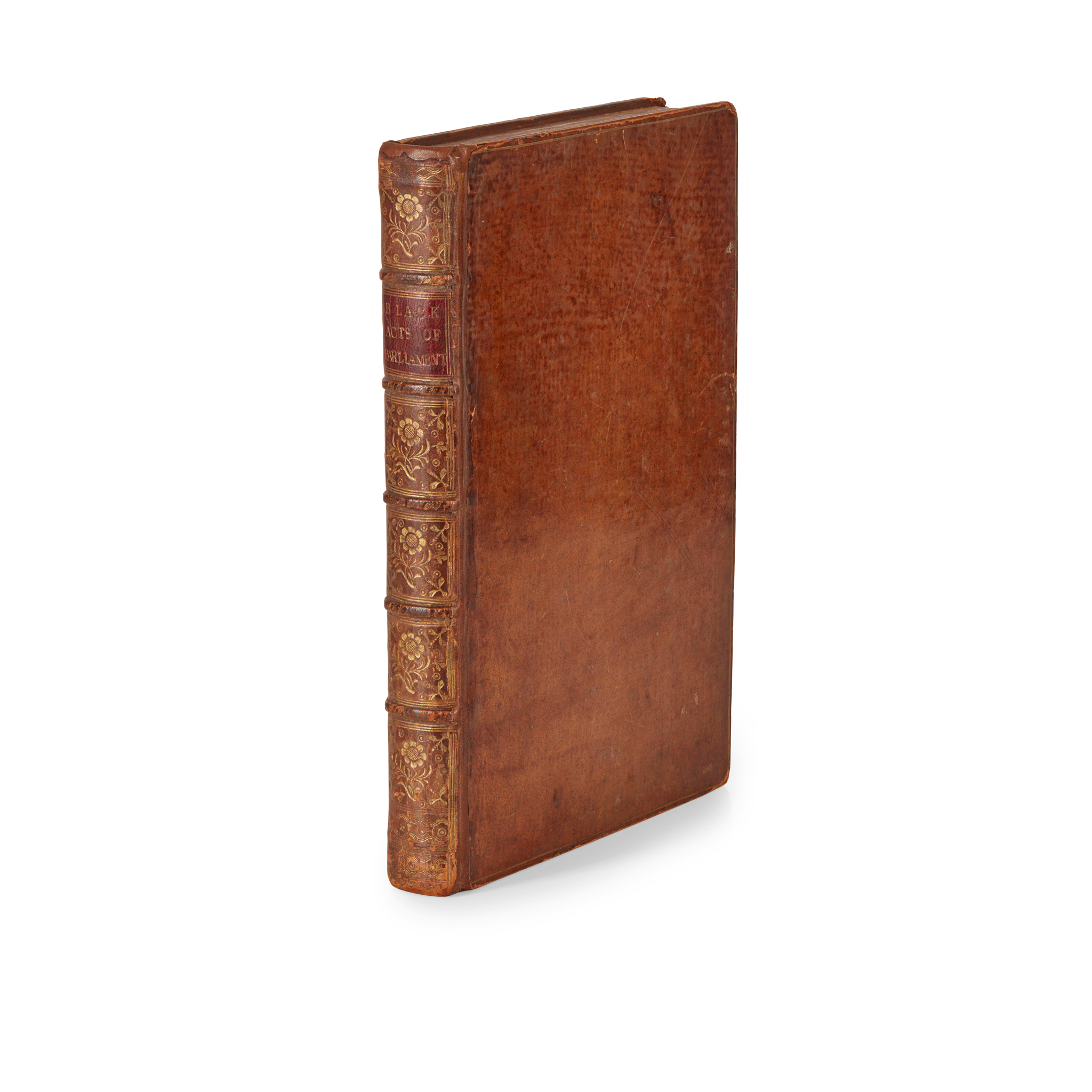Boswell, Alexander, Lord Auchinleck (1707-1782), his copy
The Actis and Constitutionnis of the Realme of Scotland
£8,190
Rare Books, Manuscripts, Maps & Photographs
Auction: 07 February 2024 from 10:00 GMT
Description
Maid in Parliamentis hald in by the rycht excellent, hie and mychtie princeis kingis James the First, Secund, Thud, Feird, Fyft, and in tyme of Marie now Quene of Scottis.
Edinburgh: Robert Lekprevik, 28th November, 1566.
First edition, second issue, folio in fours (26.3 x 17.8cm), +4 (lacking +4, blank), a-b4 c2 A-2T4 (-2L1, cancelled and not replaced, as called for; 2O1 + chi2O1; 2R2 + chi2R3.[4]) chi2U1.[2] 2U-2X4, [15] 3-132 134-145 [1] 146-158 [2] 159-168 [2] 169-182 ff., text mainly in black letter, woodcut royal arms to title-page, woodcut initials, xylographic signatures of compilers, 18th-century sprinkled calf, spine gilt in compartments, edges sprinkled red, binding rebacked with original spine laid down, rear joint partly cracked, light wear to tips, title-leaf closely trimmed and with old hand-colouring, variable damp-staining to contents, intermittent old repairs and infilling chiefly in fore margins from quire P to rear, repaired closed tear to foot of 2K3, final two leaves extended at foot, ink annotations in various hands, printed catalogue description mounted to front pastedown below pencilled ownership inscription ‘Saltcoats 9 February 1910, Albert Wood’ [STC 21876a]
Footnote
Alexander Boswell’s copy of the foundational statement of Scots law, the so-called ‘Black Acts’, acquired by him in Edinburgh in 1730, shortly after his return from legal study in Leiden, and bound with 20 leaves of manuscript excerpts from Scottish parliamentary records made at his behest by Alexander Tait (d.1781), writer to the signet.
Below Boswell’s ownership inscription, ‘Alexr Boswell, Edr 1730’, on the front free endpaper is a further inscription, in his hand but perhaps written later, reading:
‘The Black Acts of Parliament, as they are commonly called. To which is subjoin’d, in manuscript, excerpts from the records of parliament, mostly to shew who the persons were who sat in parliament in the year 1467 down to the [year] 1579. Partly extracted by myself and partly by Alexr Tait whom I employd from his known accuracy in reading old writing & faithfully copying them’.
There are two further inscriptions by Boswell, each on a separate leaf bound immediately before Tait’s manuscript, the first concerning the appointment in 1466 of Robert, Lord Boyd as regent of Scotland until the majority of James III, the second of similar content to the annotation on the front free endpaper, but adding that Tait ‘copied a multitude of manuscripts from the Advocates Library where he almost constantly was to be found’.
A leading judge, remembered by Sir Walter Scott as ‘an able lawyer, a good scholar, after the manner of Scotland, and … a strict presbyterian and whig of the old Scottish cast’, Alexander Boswell is known to posterity as the father of James Boswell, and for his tempestuous encounter with Samuel Johnson ruefully described by his son in his Journal of a Tour to the Hebrides. Having begged Johnson before their visit to Auchinleck House to avoid any talk of Whiggism or Presbyterianism, James enjoyed only a few days’ grace before an inspection of his father’s coin collection turned sour:
‘If I recollect right, the contest began while my father was shewing him his collection of medals; and Oliver Cromwell’s coin unfortunately introduced Charles the First, and Toryism. They became exceedingly warm, and violent, and I was very much distressed by being present at such an altercation between two men, both of whom I reverenced; yet I durst not interfere.’
Alexander Tait was Alexander Boswell’s fellow member of the Select Society, the elite Edinburgh debating club founded by Allan Ramsay in 1754 and attended by David Hume and others. A cultured individual whose ‘political connections were keenly whig’ (ODNB), doubtless an advantage in Boswell’s company, he became principal clerk of session in 1760 and a director of the Bank of Scotland two years later.
Commissioned by Mary Queen of Scots in a year of crisis for her regime, and a year before her deposition and flight to England, The Actis and Constitutionnis of the Realme of Scotland was the first collected edition of all public Scottish acts of parliament since 1424, during the reign of James I. The first edition was printed in October 1566; a month later a second issue was rushed out with several pieces of anti-Protestant legislation removed.
The ‘Black Acts’, as they became known on account of the gothic typeface, are remarkable to a modern audience for a reason unintended by the compilers, containing the first printed references to golf, with football also mentioned, in a succession of acts intended to prevent Scots from neglecting their military duties:
‘That ilk man busk thame to be archaris’ (James I, 1424, f. 4v.):
‘It is statute and the king forbiddis, that na man play at the fute ball under the pane of xl s. to be raist to the lord of the land’
‘Of wapinschawing’ (James II, 1457, f. 40v.):
'It is decretit and ordanit, that the wapinschawing be haldin be the lordis and barronis spirtuall and temporall, foure tymis in the year. And that the futball and golf by utterly cryit downe, and not be usit. And schuting be usit ilk Sonday … And as tuiching the futball and the golf to be punist be the barronis unlaw’
‘The length of speiris, and that yemen have targeis, and of wapinschawing’ (James III, 1471, f. 56v.):
‘And at the fute ball and golf be abusit in tyme cumming, and at the buttis be maid up and schuting usit, efter the tennour of the act of parliament maid thairupone’
‘Of wappinschawing’ (James IV, 1491, f. 92v.)
‘And attour that in na place of the realme their be usit futballis, golf, or other sic unproffitabill sportis, bot for the common gude of the realme and defence thairof’.
Provenance:
Sotheby’s, London, 12th August 1941, lot 173 (the relevant leaf from the sale catalogue is included with the lot).

